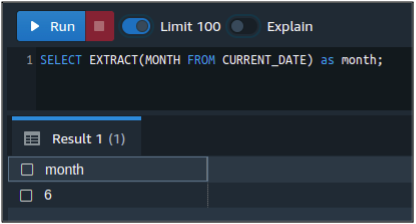
Automate ETL/ELT processes and get data flowing from hundreds of potential data sources to a single destination for analytics. With our Runnersolution, you can easily integrate your Redshift data (or other Amazon data) into your data pipeline. The SYSDATE function returns the current date and time in the current session timestamp. Learn how Zuarcan help you manage your Redshift data. Redshift provides two functions to get the current date. It is constructed with this syntax: DATEDIFF ( datepart, ) The Amazon Redshift DATEDIFF function returns the difference between the date parts of two date or time expressions. 6 min read What is the Amazon Redshift DATEDIFF function?.The cookie is set by the GDPR Cookie Consent plugin and is used to store whether or not user has consented to the use of cookies. The cookie is used to store the user consent for the cookies in the category "Performance". This cookie is set by GDPR Cookie Consent plugin. The cookie is used to store the user consent for the cookies in the category "Other. The cookies is used to store the user consent for the cookies in the category "Necessary". The cookie is set by GDPR cookie consent to record the user consent for the cookies in the category "Functional". The cookie is used to store the user consent for the cookies in the category "Analytics". These cookies ensure basic functionalities and security features of the website, anonymously. Necessary cookies are absolutely essential for the website to function properly. Note, you have to specify the datepart without quotes as listed in the syntax column.

The table below lists the most commonly used datepart formats for the Redshift datediff function. The difference in dates returned depends on the value provided to datepart as shown below. Rather, it returns the difference between the dates specified by datepart.įor example, if date1 equals 2022-July-04 and date2 equals 2021-July-04, you would expect a difference of one year when you use the datediff function. Redshift datediff does not return the cumulative difference between two dates.If you do not care for the signed part, then use the absolute value function (abs).Similarly, if the first date is greater than the second date you get a positive number.

If the first date is less than the second date, the result will be a negative number.The below 4 points are important if you want to use the Redshift datediff function correctly. What it does: The Redshift datediff function returns the difference between two dates ( date1 and date2) in the format specified by datepart. Syntax: datediff ( datepart, date1, date2) The first ( datepart) is an argument, while the second(date_part) is a date function in Redshift. You can also get the complete date part list from the Redshift documentation.Īnother point to clarify, Redshift datepart is not the same as date_part. They were chosen for being intuitive and unique to remember.

The values listed are not the complete list. The table below lists the different date parts and values in alphabetic order. If you just add time parameter up to, how many digits your need after seconds like below. It contains time with 6 digits after seconds. The value for the datepart argument is specified without quotes and in lowercase. Select now ()::time It outputs something like: 09:23:49.697401. This could be day, month, year and so on. It is a single lowercase word ( datepart) used to denote a part of a date. How do I convert from timestamp (having milliseconds) to epoch For E.g., Timestamp1 - 11:43:47.298 Timestamp2 - 11:43:47. So, let’s clear things up.ĭate part is an argument used in Redshift date functions. Though simple, its syntax and usage can get confusing. You will see datepart mentioned in more than a few Redshift date functions.


 0 kommentar(er)
0 kommentar(er)
